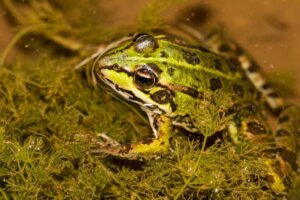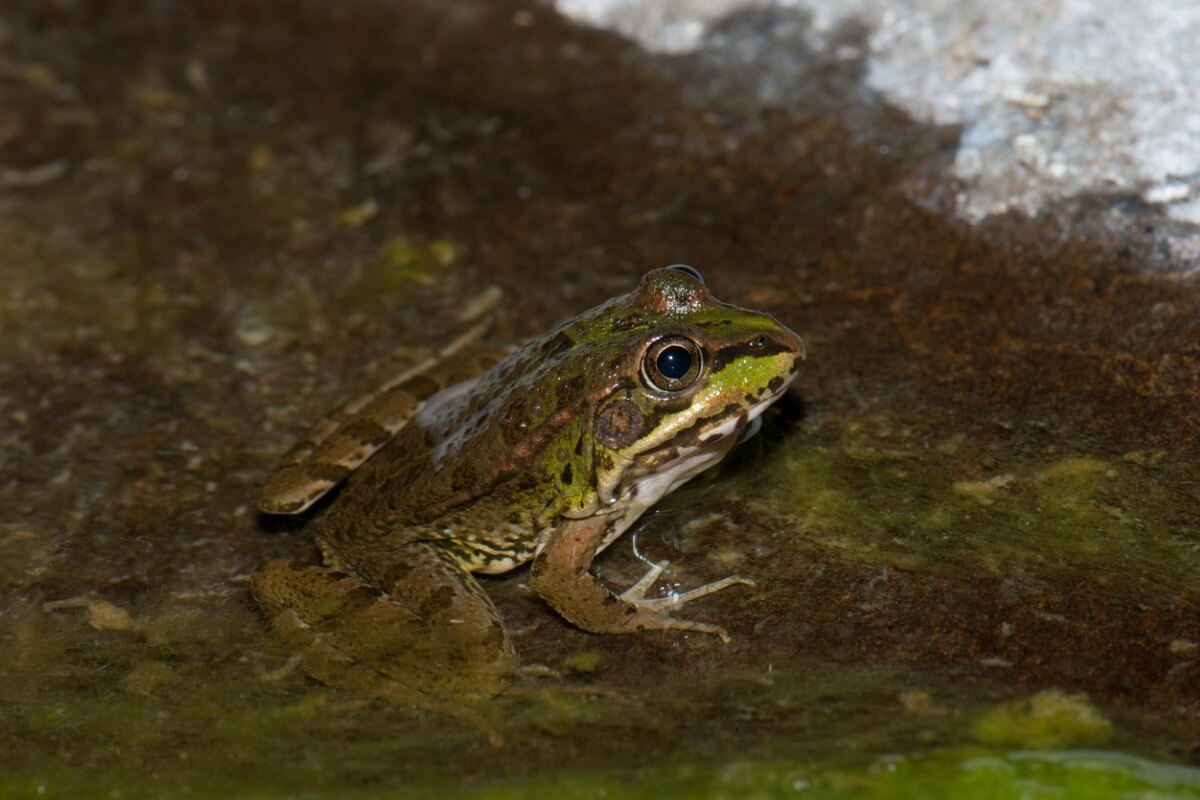Can Frogs Breathe Underwater?

The double life of amphibians requires them to show certain adaptations to water and land that are, to say the least, surprising. Therefore, when we see frogs spend large amounts of time submerged, it’s normal to wonder if they can breathe underwater.
The answer to this question has certain nuances, because it isn’t a question that can be solved with a clear “yes” or “no”. If you want to know more about how frogs breathe, don’t miss this article, as it might clear up a few questions.
How do frogs breathe?
The respiratory system of frogs changes throughout their lives. When they’re born, tadpoles live a fully aquatic life and breathe through their external gills, exchanging gas directly with the surrounding water until they develop internal gills.
Within a few days of life, the external gills of tadpoles are covered by a fold of tissue called the operculum, which leaves only one or two small openings to the outside, known as spiracles.
As it grows, the process of metamorphosis changes the frog’s entire body, causing it to shed its tail, grow limbs, and eventually lose its gills and develop lungs. At this point, the amphibian is able to go ashore without being in danger.
Once they reach the adult stage, frogs have 2 ways of breathing that allow them to stay both on land and in water. Here you can learn about them.

Lung breathing
Frogs, despite having 2 lungs, lack a diaphragm and respiratory muscles. In order to breathe, they must make convulsive movements with their throat in order to generate air in and out. To do this, most of these amphibians use a mouth pump that moves air in and out of their body. This process occurs in 2 steps:
- The frog contracts the buccal floor (or cavity) and opens the oral cavity, allowing oxygenated air from the environment to enter its body.
- At the same time, the lungs are compressed and expel the air that has already carried out the gas exchange, and that carries little oxygen. Part of it is also expelled through the nostrils.
Oxygenation through the skin
In addition to the lungs, frogs have another gas exchange system: cutaneous respiration. The skin of amphibians is very permeable and vascularized, which allows the passage of oxygen from the environment directly to the blood.
Anurans carry a series of glands that secrete a mucous substance that keeps them moisturized, which facilitates gas exchange. This is why frogs have slippery, jelly-like skin. Depending on the species, up to 100% of the oxygen uptake can take place through the epidermis at times.
Can frogs breathe underwater?
Now that we know a little more about the respiratory mechanism of amphibians, we can properly answer the question in the title: can frogs breathe underwater? The answer is affirmative: thanks to cutaneous respiration, amphibians are able to carry out gas exchange with the water they’re submerged in.
However, we need to qualify this: most frogs can’t stay submerged all the time. The gas exchange through the skin isn’t enough to oxygenate the body properly, so they have to come out to breathe from time to time. Otherwise, they would drown.
Some frog species that can breathe underwater
There are more than 6,600 species of amphibians worldwide. Each of them is adapted to the conditions of its environment, resulting in an incredible variety of specifications and peculiarities between taxa. To give you an idea, below are some examples of amazing anurans in terms of respiration.
Lake Titicaca giant frog (Telmatobius culeus)
Endemic to the lake that gives it its name, this frog has a rough, folded skin that allows it to increase the surface area for gas exchange. This is due to the fact that it’s exclusively aquatic (it has no lungs) and that the lake it lives in has a low concentration of oxygen. The more epidermal folds it has, the more O2 it intercepts.
The giant frog of Lake Titicaca is critically endangered due to hunting of adult frogs.
Barbourula kalimantanensi, the flat-headed frog of Borneo
This frog doesn’t have any lungs either, and it lives in the jungles of Borneo, Indonesia. It requires clean water with a high oxygen content, as in turbid or stagnant water this amphibian could suffocate to death.
The hairy frog (Trichobatrachus robustus)
Although the striking feature of this species isn’t strictly hair, male hairy frogs are famous for developing a series of dermal projections resembling hairy filaments during the breeding season. The purpose of these “hairs” is simply to increase the surface area for gas exchange in the water.
Although the hairy frog does have lungs, these projections are highly vascularized and also help it to extract oxygen from the aquatic environment.
The world of amphibian respiration
As you have seen, frogs can breathe underwater, but most of them also depend on oxygen from the air to survive. Exceptional species without lungs have specific adaptations to optimize as much oxygen as possible from the water.
Although it’s a fascinating adaptation, frogs’ vascularized and permeable skin poses a danger to frogs when confronted with human action in the waters they live in. The presence of pollution greatly affects the anurans, as their skin absorbs harmful chemicals easily and their lives are exposed to danger as a result.
The double life of amphibians requires them to show certain adaptations to water and land that are, to say the least, surprising. Therefore, when we see frogs spend large amounts of time submerged, it’s normal to wonder if they can breathe underwater.
The answer to this question has certain nuances, because it isn’t a question that can be solved with a clear “yes” or “no”. If you want to know more about how frogs breathe, don’t miss this article, as it might clear up a few questions.
How do frogs breathe?
The respiratory system of frogs changes throughout their lives. When they’re born, tadpoles live a fully aquatic life and breathe through their external gills, exchanging gas directly with the surrounding water until they develop internal gills.
Within a few days of life, the external gills of tadpoles are covered by a fold of tissue called the operculum, which leaves only one or two small openings to the outside, known as spiracles.
As it grows, the process of metamorphosis changes the frog’s entire body, causing it to shed its tail, grow limbs, and eventually lose its gills and develop lungs. At this point, the amphibian is able to go ashore without being in danger.
Once they reach the adult stage, frogs have 2 ways of breathing that allow them to stay both on land and in water. Here you can learn about them.

Lung breathing
Frogs, despite having 2 lungs, lack a diaphragm and respiratory muscles. In order to breathe, they must make convulsive movements with their throat in order to generate air in and out. To do this, most of these amphibians use a mouth pump that moves air in and out of their body. This process occurs in 2 steps:
- The frog contracts the buccal floor (or cavity) and opens the oral cavity, allowing oxygenated air from the environment to enter its body.
- At the same time, the lungs are compressed and expel the air that has already carried out the gas exchange, and that carries little oxygen. Part of it is also expelled through the nostrils.
Oxygenation through the skin
In addition to the lungs, frogs have another gas exchange system: cutaneous respiration. The skin of amphibians is very permeable and vascularized, which allows the passage of oxygen from the environment directly to the blood.
Anurans carry a series of glands that secrete a mucous substance that keeps them moisturized, which facilitates gas exchange. This is why frogs have slippery, jelly-like skin. Depending on the species, up to 100% of the oxygen uptake can take place through the epidermis at times.
Can frogs breathe underwater?
Now that we know a little more about the respiratory mechanism of amphibians, we can properly answer the question in the title: can frogs breathe underwater? The answer is affirmative: thanks to cutaneous respiration, amphibians are able to carry out gas exchange with the water they’re submerged in.
However, we need to qualify this: most frogs can’t stay submerged all the time. The gas exchange through the skin isn’t enough to oxygenate the body properly, so they have to come out to breathe from time to time. Otherwise, they would drown.
Some frog species that can breathe underwater
There are more than 6,600 species of amphibians worldwide. Each of them is adapted to the conditions of its environment, resulting in an incredible variety of specifications and peculiarities between taxa. To give you an idea, below are some examples of amazing anurans in terms of respiration.
Lake Titicaca giant frog (Telmatobius culeus)
Endemic to the lake that gives it its name, this frog has a rough, folded skin that allows it to increase the surface area for gas exchange. This is due to the fact that it’s exclusively aquatic (it has no lungs) and that the lake it lives in has a low concentration of oxygen. The more epidermal folds it has, the more O2 it intercepts.
The giant frog of Lake Titicaca is critically endangered due to hunting of adult frogs.
Barbourula kalimantanensi, the flat-headed frog of Borneo
This frog doesn’t have any lungs either, and it lives in the jungles of Borneo, Indonesia. It requires clean water with a high oxygen content, as in turbid or stagnant water this amphibian could suffocate to death.
The hairy frog (Trichobatrachus robustus)
Although the striking feature of this species isn’t strictly hair, male hairy frogs are famous for developing a series of dermal projections resembling hairy filaments during the breeding season. The purpose of these “hairs” is simply to increase the surface area for gas exchange in the water.
Although the hairy frog does have lungs, these projections are highly vascularized and also help it to extract oxygen from the aquatic environment.
The world of amphibian respiration
As you have seen, frogs can breathe underwater, but most of them also depend on oxygen from the air to survive. Exceptional species without lungs have specific adaptations to optimize as much oxygen as possible from the water.
Although it’s a fascinating adaptation, frogs’ vascularized and permeable skin poses a danger to frogs when confronted with human action in the waters they live in. The presence of pollution greatly affects the anurans, as their skin absorbs harmful chemicals easily and their lives are exposed to danger as a result.
All cited sources were thoroughly reviewed by our team to ensure their quality, reliability, currency, and validity. The bibliography of this article was considered reliable and of academic or scientific accuracy.
- Andrade, P., Elías, R., Grandez, R., & Mamani, J. (2018). Descripción histológica de la piel de la rana gigante del Titicaca (Telmatobius culeus). Revista de Investigaciones Veterinarias del Perú, 29(1), 64-74.
- Barbourula kalimantanensis. (2019). AmphibiaWeb. https://amphibiaweb.org/species/2039
- Smyth, D. H. (1939). The central and reflex control of respiration in the frog. The Journal of physiology, 95(2), 305.
- MacRobbie, E. A., & Ussing, H. H. (1961). Osmotic behaviour of the epithelial cells of frog skin. Acta Physiologica Scandinavica, 53(3‐4), 348-365.
This text is provided for informational purposes only and does not replace consultation with a professional. If in doubt, consult your specialist.








